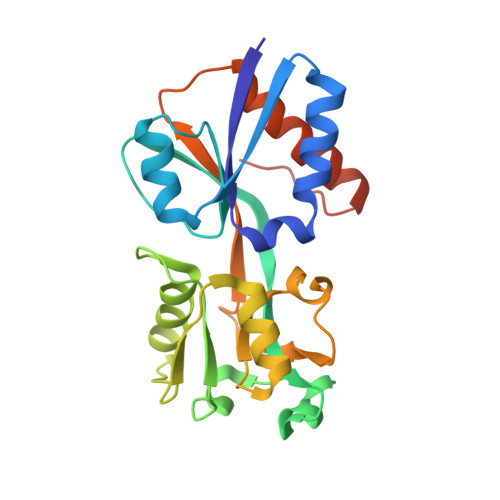Inducer responses of BenM, a LysR-type transcriptional regulator from Acinetobacter baylyi ADP1.
Craven, S.H., Ezezika, O.C., Haddad, S., Hall, R.A., Momany, C., Neidle, E.L.(2009) Mol Microbiol 72: 881-894
- PubMed: 19400783
- DOI: https://doi.org/10.1111/j.1365-2958.2009.06686.x
- Primary Citation of Related Structures:
2H99, 2H9B, 3GLB - PubMed Abstract:
BenM and CatM control transcription of a complex regulon for aromatic compound degradation. These Acinetobacter baylyi paralogues belong to the largest family of prokaryotic transcriptional regulators, the LysR-type proteins. Whereas BenM activates transcription synergistically in response to two effectors, benzoate and cis,cis-muconate, CatM responds only to cis,cis-muconate. Here, site-directed mutagenesis was used to determine the physiological significance of an unexpected benzoate-binding pocket in BenM discovered during structural studies. Residues in BenM were changed to match those of CatM in this hydrophobic pocket. Two BenM residues, R160 and Y293, were found to mediate the response to benzoate. Additionally, alteration of these residues caused benzoate to inhibit activation by cis,cis-muconate, positioned in a separate primary effector-binding site of BenM. The location of the primary site, in an interdomain cleft, is conserved in diverse LysR-type regulators. To improve understanding of this important family, additional regulatory mutants were analysed. The atomic-level structures were characterized of the effector-binding domains of variants that do not require inducers for activation, CatM(R156H) and BenM(R156H,T157S). These structures clearly resemble those of the wild-type proteins in their activated muconate-bound complexes. Amino acid replacements that enable activation without effectors reside at protein interfaces that may impact transcription through effects on oligomerization.
Organizational Affiliation:
Department of Microbiology, University of Georgia, Athens, GA 30602-2605, USA.

















